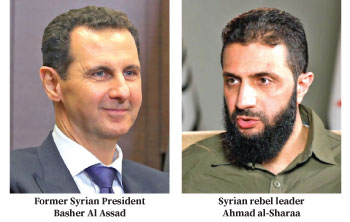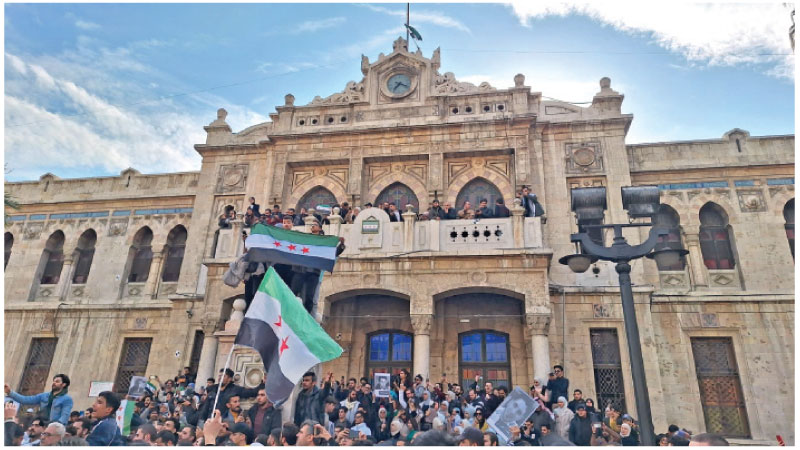 When ferocious-looking and sounding, little-known, Arab Islamist insurgent leaders last Tuesday webcast their brief first rant to the world from the steps of Damascus’s main mosque – itself a sacred, ancient, Islamic site – observers were quick to note their silence on Palestine and little mention of most Arab Islamists’ traditional ‘enemy’, the West, including the USA. This was despite the ongoing bombardments of the Syrian metropolitan region by Israel and overrunning of the Syrian Golan Heights territory even as those triumphant rebels were speaking.
When ferocious-looking and sounding, little-known, Arab Islamist insurgent leaders last Tuesday webcast their brief first rant to the world from the steps of Damascus’s main mosque – itself a sacred, ancient, Islamic site – observers were quick to note their silence on Palestine and little mention of most Arab Islamists’ traditional ‘enemy’, the West, including the USA. This was despite the ongoing bombardments of the Syrian metropolitan region by Israel and overrunning of the Syrian Golan Heights territory even as those triumphant rebels were speaking.
Analysts noted the repeated reference to the Umma, namely the world Muslim community, and promises to march on the Al Aqsa Mosque and Mecca. Palestine-Israel was unmentioned although for decades, the liberation of Palestine was a basic tenet of the entire spectrum ofArab nationalism across the world.
 But a wide spectrum of analysts of the Arab world and internationally, however, point out that the victorious rebels are funded and armed by the Western power bloc and will remain dependent on the West for their new regime’s success in Damascus. No one, then, expects the new Syria to continue to be hostile to either the West or to colonial protégé Israel.
But a wide spectrum of analysts of the Arab world and internationally, however, point out that the victorious rebels are funded and armed by the Western power bloc and will remain dependent on the West for their new regime’s success in Damascus. No one, then, expects the new Syria to continue to be hostile to either the West or to colonial protégé Israel.
Indeed, most analysts recognise a serious re-drawing of the geopolitical map of West Asia in favour of the West and completely and tragically against any possibility of ending the horror that is war-torn Palestine. The way Israel has already begun wave after wave of aerial strikes inside Syria, damaging the country’s military logistics, vital transport routes and hubs and even some energy installations, is a clear indication of that aggressor Western proxy state’s ‘licence’ for further aggression.
The Israeli Defence Forces (IDF) has already moved further into Syria, annexing strategically useful territory along the Golan Heights, most of which has already been forcibly occupied in the 1967 Six-Day war by Israel. A freshly arrogant Israeli Premier, the internationally ‘wanted’ Benjamin ‘Bibi’ Netanyahu, quite illegally visited the Golan Heights last week to posture in triumph over the defeat of former Syrian President Bashar-al-Assad, even as he took to the witness box in his long-running court case over corruption charges.
Regime-change in ancient, historic and once prosperous Damascus (it prospered under the old Baathist State’s secularism and modernism) has also dislodged Iran’s influence in Syria and, hence, the lavish Iranian support channelled through Syria to the Hezbollah and other anti-Western movements in Lebanon.
The loss of Syria is, thereby, a major blow to the Lebanese militia and Lebanon-based Palestinian refugee militia that have long resisted the Israeli occupation of Palestine and continuing ethnic cleansing of the Arab population in Palestinian territory. How much this prolongs the immense suffering of the Palestinian nation will now be decided more by the ongoing re-alignment of global geopolitical forces and not only the armed resistance by the Palestinians themselves.
Iran, however, also has its other, stronger, ally in the nascent Yemeni Republic led by the Houthi tribal confederation that has effectively replaced the earlier Saudi-supported Yemeni military Government – at least in the western half of civil war-torn Yemen. The Houthi regime has the benefit of a much bigger territory, its own natural and economic resources (both oil, agri-exports, ports) and also the safety of a significant distance from Israeli military strike capability.
Analysts are also keenly watching Russia’s intense back-room negotiations with the victorious rebels and Turkiye on the future of the several Russian military bases that have been hosted by the socialistic Syrian Baathist state for over a half-century during and after the Cold War.
Russia
Russian naval and airbases along Syria’s Mediterranean seaboard are the only major Russian military installations outside Russia. They have so far been a significant counter to the massive US military presence in the Mediterranean theatre. How long can Turkiye tolerate this Russian, anti-NATO presence to its south?
All this will hinge on who will dominate the new regime in Damascus and their loyalty to Western sponsors. The wildly complicated composition of the rebel movement now victorious over the Baathist state must be understood for any forecast of Syria’s and West Asia’s future.
All analysts acknowledge that the hotchpotch of anti-Government forces in Syria became ‘forces’ in a military sense only because of constant funding and logistical support from the West. For nearly 14 years since the spontaneous region-wide ‘Arab Spring’ urban revolt against some authoritarian Arab regimes, the Western bloc has been busily arming and financing those rebel groups.
These rebel groups in Syria range from the radical Islamist groups, including those originated by Al Qaeda and the Islamic State (IS), to secular Leftist and Right-wing Liberal citizens movements that, egged on by Washington, formed their own militia.
The Western arms and equipment were mainly channelled overland into Syria through Turkiye, the crucial sole NATO member located geophysically outside Europe (Turkiye’s Anatolian Peninsula is demarcated as part of the Asian continent). Ankara added its own largesse to anti-Damascus forces, with an eye to also curbing the anti-Assad regime Syrian Kurdish secessionist rebel groups from activating the marginalised Kurdish minority community in Turkiye.
The Kurdish dimension is even more complicated. On the one hand, Turkiye wants the Syrian anti-Government rebels to distance themselves from the anti-Damascus Syrian Kurds separatists – because those Kurds also support Turkiye Kurdish separatism. On the other hand, the US and other NATO forces that have infiltrated Syria ever since they occupied Iraq to the west of Syria in the early 2000s, have consolidated their control of the (barely tapped) Syrian oil and gas fields by befriending those same Syrian Kurdish separatists. But the Kurdish independence struggle is a ‘side story’ that will remain even after the fall of Assad.
Collection of rebel groups
What happened last week was the dramatic defeat of the Assad regime and take-over of Damascus by the motley collection of rebel groups that had, for over a decade, held the Northwestern corner of Syria. Their constant disunity – partly the sharp ideological divergences and partly tribal and regional community divisions – has always been a major weakness of the anti-Assad coalition.
So much so, that only recently, these columns doubted the capacity of this coalition to effectively replace the Baathist regime in running the country. Now, the ‘coalition’ is supposed to have been victorious but already analysts note that only the most dominant militia, the Islamist radical movements, have asserted their control over the capital city.
The Islamist groups seem to be forging a new administration with their own personnel, excluding the secularist and liberal sections of the coalition.
The dominant militias of this rebel coalition were the many radical Islamist fundamentalist militia, the most powerful of which is the Hayat Tahrir al-Sham (HTS) group that swept long-time Syrian dictator Assad from power last Sunday at the head of the rebel alliance. The HTS (in English: Organisation for the Liberation of the Levant) is well known to have originally been the Al Nusrat Front formed as an arm of the old Islamic State led by the late Emir Al Baghdadi (killed in an US aerial strike in his northern Iraq hide-out).
The HTS’ founding leader, Abu Mohammed al-Golani (his ‘war name’), was originally in the leadership of the Al Nusrat Front and a close associate of Al Baghdadi. However, after gaining prominence in the anti-Assad rebellion, al-Golani distanced himself and Al Nusrat from the Al Qaeda and IS networks.
It is possible that the easier access to lavish Western arms supplies which would strengthen his hand, was the carrot that motivated Al Golani to break free from his fundamentalist branding by dissolving Al Nusrat and creating the HST. During the period of the Syrian Civil War, he clearly worked to re-brand himself, renouncing ties to al-Qaeda and depicting himself as a champion of pluralism and tolerance.
Reportedly it was only last week, as Al Golani entered Damascus behind his victorious militia columns, that he dropped his nom-de-guerre and referred to himself with his real (birth) name, Ahmad al-Sharaa.
Now, al-Sharaa’s Islamist HTS group has moved quickly to impose its dominance over Syria’s state. News agencies report that the HTS is deploying its own police service brought in from its home base in northwest Syria.
The HTS’ own ‘Government’ in its Northern Idlib province base has reportedly been transplanted in Damascus, as an ‘Interim Government’ for Syria. Its officials have already begun meeting foreign envoys – raising concerns over how inclusive Damascus’ new rulers intend to be.
Sharaa’s formerly Idlib-based bureaucracy comprises experienced administrators and gives the HTS an edge over the more ragtag and small Liberal and secularist militias that also comprise the rebel coalition. Even if HTS is not directly relating to the Western Governments, Ankara is known to be serving as the middle-man in this convoluted relationship in which HTS is yet classified as a ‘terrorist’ organisation by the West, with Sharaa himself having a US$ 10 million bounty on his head.
Analysts said the appointment of Mohammed al-Bashir, the head of the HTS’s Idlib enclave Government, as Syria’s new interim Prime Minister last week, underlines the group’s currently emerging grip on power in Damascus.
As the sick carnage in Palestine continues in front of the entire world community and the West that sponsors this prepares for the celebration of Christmas, events in the latest victim of Western intervention, Syria, will indicate to humanity how much hope remains in this Season of Hope.









